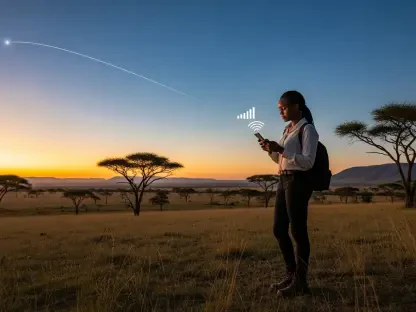I’m thrilled to sit down with Vladislav Zaimov, a seasoned telecommunications specialist with deep expertise in enterprise telecom solutions and risk management for vulnerable networks. With years of experience navigating the complexities of this ever-evolving industry, Vladislav offers a unique perspective on the challenges and innovations shaping connectivity today. In our conversation, we dive into critical topics such as financial resilience in the face of market pressures, the ambitious rollout of next-generation infrastructure, the surge in high-speed mobile networks, and the strategic moves telecom giants are making to stay ahead. Join us as we explore the intricacies of building the digital backbone of the future.
Can you shed light on the financial landscape for major telecom players like BT, particularly how they’ve navigated revenue declines in recent reports?
Absolutely, Andrew. Looking at BT’s recent performance, their first-half revenue dropped by 3% to about $12.83 billion. This decline largely stems from ongoing challenges in legacy voice services, softer mobile handset sales, and reduced international trading. However, they’ve managed to offset some of this through a stronger focus on full fiber broadband offerings via their infrastructure arm, Openreach. It’s a classic case of legacy systems dragging down the numbers while newer, high-growth areas start to pick up the slack. The telecom industry often faces this transition pain, and BT’s experience mirrors broader trends where traditional revenue streams are shrinking faster than new ones can fully compensate.
How are telecom companies maintaining profitability despite pressures like wage costs and legacy declines?
It’s all about cost transformation and operational efficiency. For instance, BT kept their adjusted EBITDA steady at £4.1 billion despite these headwinds. They’ve likely leaned heavily on streamlining operations, renegotiating supplier contracts, and automating processes to cut costs. Higher wage costs and legacy declines are tough, but by focusing on high-margin services like fiber broadband and mobile data plans, they can balance the books. It’s a delicate act—investing in the future while managing the decline of older revenue sources—but strategic cost-cutting and a pivot to digital services are key to staying resilient.
What’s driving the significant increase in capital expenditure for infrastructure projects in the telecom sector?
The surge in capital expenditure, like BT’s 8% increase to £2.4 billion, is primarily tied to the massive push for next-generation networks, especially full fiber broadband. Building out fiber-to-the-premises (FTTP) infrastructure is capital-intensive—think laying cables, installing equipment, and reaching remote areas. For BT, this investment directly correlates with their record rollout of 2.2 million premises in just six months. It’s not just about scale; it’s about future-proofing their network to meet exploding demand for high-speed internet, which is critical for everything from remote work to streaming. Without this spend, they risk falling behind competitors who are also racing to deploy fiber.
How significant is the milestone of reaching over 20 million premises with full fiber broadband, especially in rural areas?
It’s a game-changer, Andrew. BT’s Openreach hitting 20.3 million premises, with 5.5 million in rural areas, signals a major step toward closing the digital divide. Rural connectivity has always been a challenge due to lower population density and higher costs per connection, so reaching over 5 million rural premises shows a real commitment to inclusivity. This isn’t just about numbers; it’s about enabling economic growth, education, and access to services in areas that have historically been underserved. It’s a foundational move for a more connected society, and it positions companies like BT as leaders in national infrastructure.
What factors are fueling the record demand for full fiber connections, with millions of new customers signing up?
The demand spike—BT added 1.1 million new FTTP customers in the first half—comes down to a perfect storm of necessity and opportunity. The pandemic shifted how we live and work, with remote setups and digital entertainment becoming non-negotiable. Full fiber offers speeds and reliability that older copper networks just can’t match, so consumers and businesses are jumping at the chance to upgrade. Plus, as coverage expands, awareness grows, and competitive pricing from providers sweetens the deal. It’s also a status symbol in a way—having the fastest internet is a selling point for homes and a productivity booster for companies.
Turning to mobile networks, how does maintaining a top position in 5G coverage impact a company’s standing in the market?
Holding the title of the UK’s top mobile network for 12 years straight, as BT’s EE has done, is a massive trust signal. It tells customers they’re getting reliability and cutting-edge tech, which is huge in a competitive space. Extending 5G+ coverage to 66% of the population and growing the 5G customer base by 11% to 13.9 million further cements this dominance. It’s not just about bragging rights; it translates to customer loyalty, higher ARPU (average revenue per user), and a stronger foothold against rivals. In telecom, network quality is often the deciding factor for consumers, so this leadership directly boosts market position.
Can you explain the difference between standard 5G and 5G+, and why this enhanced coverage matters to users?
Sure, Andrew. Standard 5G already offers faster speeds and lower latency compared to 4G, but 5G+—often referring to 5G Standalone—takes it further by operating on a fully independent 5G core network, not reliant on 4G infrastructure. This means even better performance, ultra-low latency, and support for advanced use cases like IoT, autonomous vehicles, and real-time applications. Covering 66% of the population with 5G+ means millions can access these next-level capabilities, which is crucial for both individual users wanting seamless streaming or gaming and businesses relying on real-time data. It’s a stepping stone to transformative tech adoption on a national scale.
What’s your forecast for the future of 5G and full fiber rollout in shaping how we connect over the next decade?
I’m incredibly optimistic, Andrew. Over the next ten years, 5G and full fiber will be the backbone of a hyper-connected world. We’re looking at near-universal coverage, with 5G+ becoming the norm and fiber reaching even the most remote corners. This will unlock innovations we’re only beginning to grasp—think smart cities, widespread telehealth, and immersive augmented reality. The challenge will be balancing cost with accessibility, but with the momentum we’re seeing now, I believe telecom providers will drive a digital revolution that fundamentally changes how we live, work, and interact. It’s an exciting time to be in this space.









